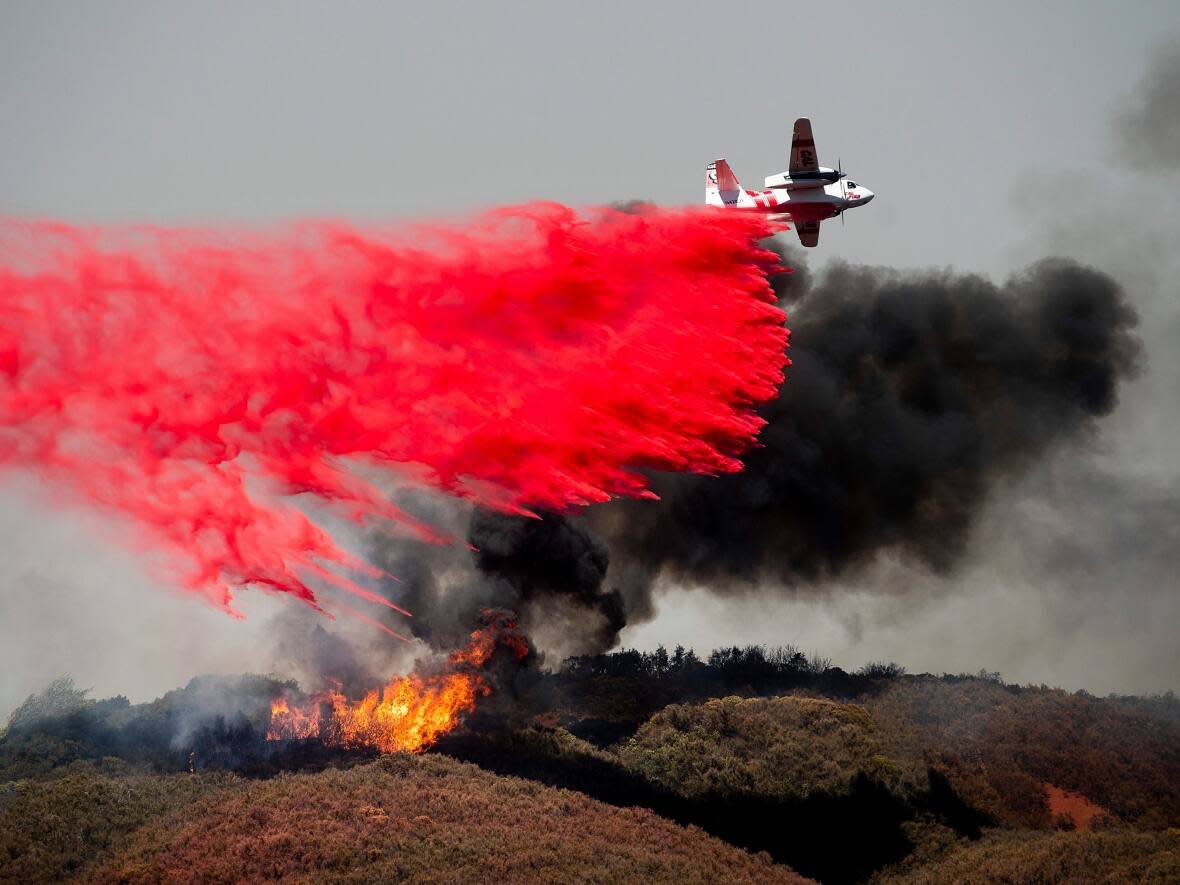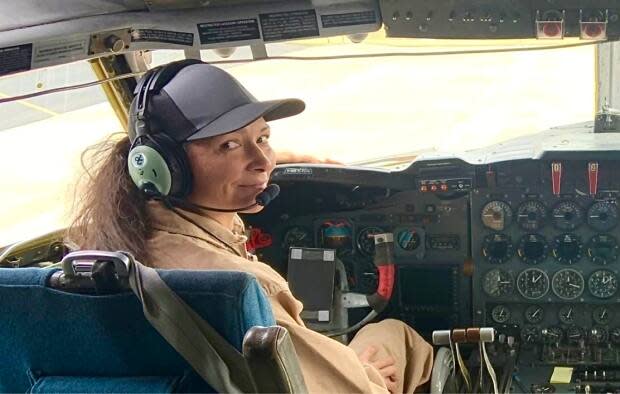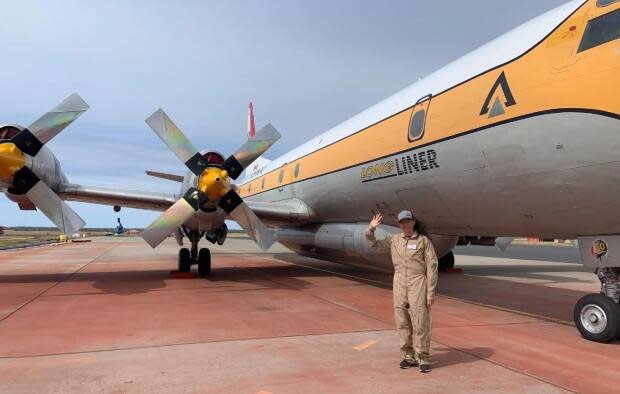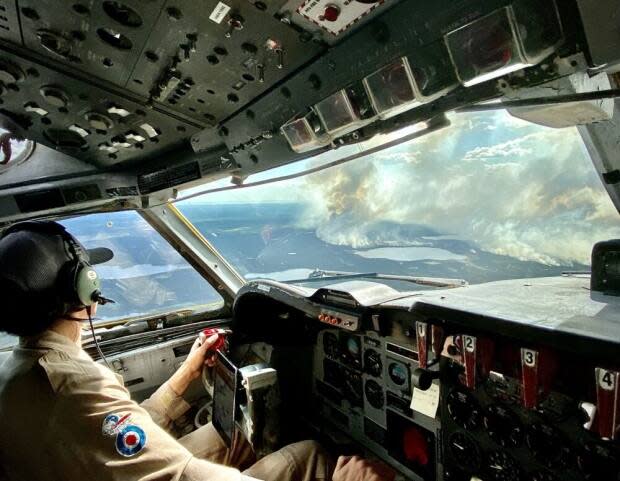Fighting fire from the sky: A glimpse inside the giants of Alberta's wildfire fleet

When the fight against Alberta wildfires takes to the sky, airtankers are the giants of the fleet.
Airtankers have been a mainstay in Alberta's aerial firefighting arsenal for years. Following a record 2023 wildfire season, the province has plans to upgrade the fleet and add more machines to its water-bombing crews.
Unlike smaller skimmer planes that fill their tanks with water in seconds, airtankers have a much larger payload, carrying thousands of litres of fire retardant to the flames with each mission.
Cristalle Fairbank, a pilot with Red Deer-based Air Spray Airtankers, said airtankers will always serve as "the muscle" in the fight against wildfires.
This is Fairbank's 12th season fighting fires from above, painting the forest bright red at breathtakingly low altitudes.
"I love flying and it's an exciting type of flying to do," said Fairbank, 45. "It's all hand-flown. We don't have an autopilot.
"We're aiming for 100 feet above the treetops."

The most challenging hours behind the controls come when Fairbank knows the flames have put a community under threat.
Most recently, she and her crew were called to Fort McMurray to battle a fire that had forced the evacuation of thousands of residents from four neighbourhoods.
"When it's affecting life and property, it's more stressful," she said. "Knowing that they're having evacuations going on is always in the back of your mind."
Fairbank fights fires from the cockpit of a four-engine Lockheed L-188 Electra, one of two under contract to the Alberta government.
The planes once carried around 100 passengers on commercial flights but have been repurposed as effective weapons in the wildfire fight.
Flying at speeds up to 674 kilometres per hour, they can drop 11,356 litres of retardant with each load.
WATCH | Airtanker drops payload of retardant:
The provincial fleet consists of nine groups of one or more airtankers that can be deployed to fight fires anywhere in Alberta.
In all, Alberta operates and contracts 18 aircraft in its airtanker fleet, including four Canadair CL-215Ts, four smaller Fire Boss skimmers and 10 heavy tankers that drop fire retardant.
The aircraft are deployed from 13 airtanker bases scattered throughout the province in Hinton, Slave Lake, Rocky Mountain House, Manning and other communities.
The province has expanded its aerial firefighting capacity this season, hiring night-vision helicopters for the first time and purchasing four of its own planes.
During a news conference this week, Forestry Minister Todd Loewen said the province is exploring how to add more bombers to its fleet.
This year's budget earmarked $55 million for new wildfire fighting equipment, including airtankers.
The province has also committed $151 million over three years for enhancements to the wildfire management program, including airtanker support.

Loewen said the province has started exploring how to replace the existing fleet with one that can better address the demands of each season.
"We added two more airtanker groups and, looking into the future, we're looking at possibly purchasing some more airtankers to have on our own personal fleet," he said.
"Those discussions are still underway … it does take a long time to procure them."
Retardant dropped by airtankers helps slow down the progress of the flames, clearing the way for ground crews.
Sometimes crews are called on to blanket a hot spot, or to halt a crown fire — bringing the flames down from the top of the trees to the ground, where they can be more easily contained.

Each drop is carefully choreographed. A plane known as a bird dog arrives first to monitor the fire and draft a plan of attack.
Highly trained firefighters working as air attack officers sit beside the bird dog pilot and co-ordinate other aircraft on the mission, directing each drop to ensure the retardant hits the best spot.
"The bird dogs are the brains and we're the muscle." - Cristalle Fairbank
Fairbank, who began her career as a bird dog pilot, said the rest of the fleet waits for instructions in what is known as a stack formation.
Each plane is given its own slice of airspace, a set window of altitude that ensures that the aircraft remain safety spaced apart in the sky.
The lowest aircraft in the stack is deployed first before returning to the nearest tanker base where a ground crew fills it with another load of retardant. The cycle repeats, sometimes for hours.
"We're basically the brawn," Fairbank said of the tankers. "The bird dogs are the brains and we're the muscle."
A travelling 'pack'
Aerial firefighting is a transient life. Fairbank and her team — two pilots, an air-attack officer and two engineers — will stay together throughout the season but could be deployed anywhere, anytime.
Her crew has been stationed at the airtanker base in Manning, but if a fire flares, orders from Alberta Wildfire could put her "summer family" on the move, Fairbank said.
"They will give us a day's heads-up and we'll pack our things," she said. "We travel as a pack."
Fairbank, who grew up in Sherwood Park, Alta., and now lives in Kimberley, B.C., didn't have early dreams of becoming a pilot. She fell in love with flying during her summers in university.
She was working as a tree planter between semesters and realized her favourite part of the day was catching a helicopter ride.
She earned a degree in linguistics and then pursued her private flying licence. After meeting some of the crew at Air Spray, she got fully certified so she could join them each wildfire season.
More than a decade later, she has no intention of stepping out of the cockpit.
"I love the job," she said. "There's nothing mundane about it. You just never know where you're going to be and I feel like we are helping.
"I like being part of something good."


